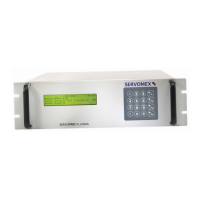User Manual SERVOPRO Plasma Trace N
2
Analyzer
2.0 CAUTIONS AND WARNINGS
5
2.5 General precautions for handling and storing high pressure cylinders
This analyzer is frequently applied to verify the contents of high-pressure cylinder gases.
Mishandling of gas cylinders could result in death, serious injury or property damages. Handle
gas cylinders with extreme care. Refer to general precautions for handling and storing high-
pressure cylinders. Here are some precautions from the COMPRESSED GAS ASSOCIATION'S
HANDBOOK.
1.
Never drop cylinders or permit them to strike each other violently.
2. Cylinders may be stored in the open, but in such cases, should be protected against extreme
weather. To prevent rusting, keep away from the dampness of the ground.
3.
The valve protection cap should be left on each cylinder until it has been secured against a
wall or a bench, or placed in a cylinder stand until it is ready to be used.
4. Avoid dragging, rolling, or sliding cylinders, even for a short distance; they should be moved
by using a suitable hand-truck.
5. Never tamper with safety devices in valves or cylinders.
6. Do not store full and empty cylinders together. Serious suck back can occur when an empty
cylinder is attached to a pressurized system.
7. No part of a cylinder should be subjected to a temperature higher than 125
o
F (52
o
C). A
flame should never be permitted to come in contact with any part of a compressed gas
cylinder.
8. Do not place cylinders where they may become part of an electric circuit. When electric arc
welding, precautions must be taken to prevent striking an arc against the cylinder.
Edited from selected paragraphs of the Compressed Gas Association's
"Handbook of Compressed Gases" published in 1981.
Compressed Gas Association
1235 Jefferson Davis Highway
Arlington, Virginia 22202
2.6 Gas hazard
Argon and helium are member of the rare gas family which consist of helium, argon, krypton,
xenon or neon.
All of these gases are monoatomic and are characterized by their extreme chemical inactivity.
They are colorless, odorless, tasteless and NON TOXIC.
However, these gases can act as a simple asphyxiate by displacing the necessary amount of
oxygen to support life. Proper ventilation must be done to provide safe area.

